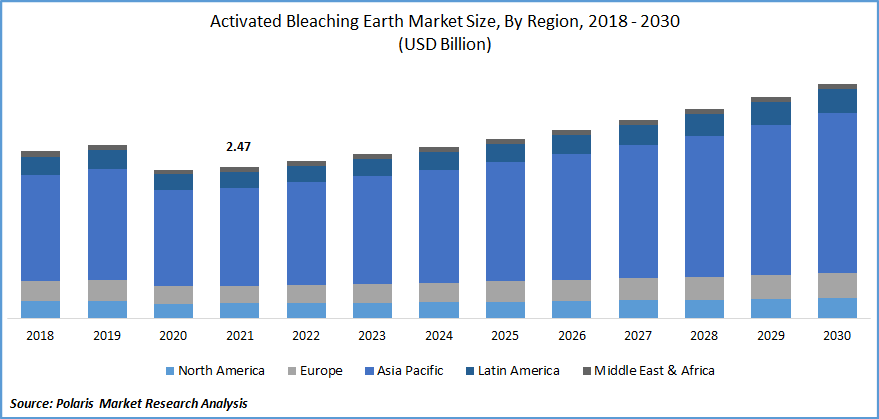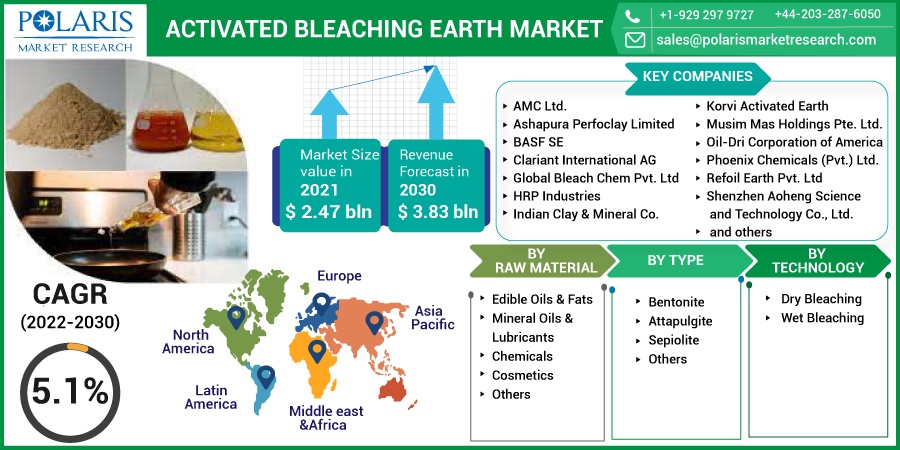
Activated Bleaching Earth Market Share, Size, Trends, Industry Analysis Report
By Application (Edible Oil & Fats, Mineral Oil & Lubricants, Chemicals, Cosmetics, Others); By Technology; By Type; By Region; Segment Forecast, 2022 - 2030
- Published Date:Jun-2022
- Pages: 115
- Format: PDF
- Report ID: PM1159
- Base Year: 2021
- Historical Data: 2018-2020
Report Outlook
The global activated bleaching earth market was valued at USD 2.47 billion in 2021 and is expected to grow at a CAGR of 5.1% during the forecast period. The rising effectiveness of activated bleaching earth compared to other absorbents will likely enhance the market growth for activated bleaching earth in the forecast period.

Know more about this report: Request for sample pages
The clay mine rich in minerals collected from the ground is referred to as activated bleaching earth. These materials are mostly used to purify edible oils and animal fats for human food by removing impurities and undesired substances such as trace metals, coloring additives, and carotenoid content, among other things.
Activated bleaching is a commonly used absorbent with bleaching and filtration capabilities. It's widely used to refine edible oils, including vegetable and seed and animal-based oils like fish. The product refines, purifies, and decolorizes the oil, allowing it to be consumed by humans.
The increased edible oil and fat production is expected to boost the activated bleaching earth market forward. As per the Economic Survey 2022, India's cooking oil imports will grow at the rate of 3.4% per year, till 2030, due to increasing urbanization and modifying dietary habits with a transition toward highly processed foods containing vegetable oils.
In comparison to other international market sectors, the size of the activated bleaching earth market has also shrunk dramatically during COVID-19. This activated bleaching earth market industry, like other sectors, is experiencing a scarcity of raw materials as well as other industrial equipment and accessories.
However, in today's world, every manufacturing business desires innovative equipment, and the global market has significantly expanded as a result of this. The global market for activated bleaching earth, as well as the prominent investors and market important shareholders, have suffered a significant loss in their business lines as a result of the suspension of international commercial vehicles. Several regions are also willing to spend considerable money on building excellent infrastructure facilities to combat global disease.
Industry Dynamics
Growth Drivers
The main driver of the market is the rising demand for edible oils. The increase in the mineral oil sector is expected to cushion the market. Bleached clay treats various mineral oils, such as lubricants and hydrocarbons. Because of its expanding use in manufacturing lubricants and greases, food processing, thermofluids, biomedicines, waxes, cosmetics, and health supplements, the mineral oil sector is predicted to increase internationally.
The expanding number of health-conscious customers, population increase, and changing living standards will likely drive up per capita use of vegetable oils in food applications in both developed and developing countries in the future. Due to increasing market demand from food and other industrial companies in the region, Asia Pacific saw the fastest rise in edible oils & fats globally. As a result, consumption of activated bleaching earth for the market application of edible oils & fats is likely to rise over the predicted period.

Know more about this report: Request for sample pages
Report Segmentation
The market is primarily segmented based on application, type, technology, and region.
|
By Raw Material |
By Type |
By Technology |
By Region |
|
|
|
|
Know more about this report: Request for sample pages
Dry bleaching is expected to witness fastest growth
Various advantages of dry bleachings, such as cost-effectiveness and ease of use, boost the segmental growth. The standard method for bleaching oils & fats is dry. It's most popular in Europe and Asia, although it's used worldwide. The dry method is much cheaper than wet bleaching, as it demands a far lower initial expenditure.
Due to the use of plate heat exchangers, which is needless utility usage, the running expenses are also much lower. The procedure is simple, requiring only a small amount of setup space. Wet bleaching, on the other hand, incorporates water into the process.
Edible oils & fats accounted for the highest market share in 2021
The increased output of vegetable oil is responsible for expanding this application category. Factors such as the advantage of the growth of decolorized and extremely purified low-fat oil in developed and developing countries, as well as gradually and progressively of edible oil in countries like India and China, are predicted to propel the growth of activated earth. The increased use of vegetable oil in the production of biofuels is expected to drive increasing demand for edible oil & fats products.
Bentonites is expected to hold the significant revenue share
Bentonites are soft stones that can absorb compounds dissolved in water or other liquids. The minerals evolved throughout time as volcanic ash adapted to its surroundings. The natural bleach earth is an absorbent kind of bentonite or attapulgite clay in its natural state. It's processed, but it's done physically rather than chemically.
The activated bleach earth is made from bentonite clay but has a more significant concentration of montmorillonite than regular bentonite clay. Chemical treatment is applied to activated bleaching earth to change the clay and make it more propitious. Thus, these benefits are assisting the bentonites segment in witnessing growth.
The demand in Asia Pacific is expected to witness significant growth
Asia Pacific led the global market for activated bleach earth. China is the major consumer and producer of vegetable oil in the region. Consumption outnumbers production despite the high output volume, leading to higher import volumes than export volumes.
According to the UN Food and Agriculture Organization, India is the world's second-largest producer and importer of vegetable oils. India is anticipated to sustain a high per capita consumption growth rate of 3.1 percent per year, reaching 24 kg per capita by 2027.
In February 2022, India imported 1,019,997 metric tonnes of vegetable oils, with 983,608 metric tonnes of edible oils and 36,389 metric tonnes of non-edible oils. Compared to February 2021, when India imported 838,607 tonnes of vegetable oils, imports of vegetable oils increased by 22%.
According to data from the Ministry of Agriculture, India is the world's top importer of vegetable oils, followed by China and the United States. Palm oil accounts for around 60% of all imported edible oils, with soyabean oil accounting for 25% and sunflower oil for 12%.
South America is a significant producer of edible oil around the world. A large portion of its exports, including foodstuffs to raw resources, is critical to the continent's manufacturing. According to a fact sheet by the OECD/Food and Agriculture Organization of the United Nations, Brazil will overtake Argentina as the country's biggest exporter of soybean oil in the next decade. Argentina is one of the nation's top vegetable oil export industries, ranking third behind Malaysia and Indonesia. Thus, these factors are assisting the region is growing rapidly.
Competitive Insight
Major players operating in the global market for activated earth include AMC Ltd., Ashapura Perfoclay, BASF SE, Clariant International, Global Bleach Chem, HRP Industries, Indian Clay., Korvi Activated, Musim Mas Holdings, Oil-Dri Corporation, Phoenix Chemicals., Refoil Earth, Shenzhen Aoheng, Taiko Group, and The W Clay Industries.
Recent Developments
In January 2022, Clariant's Worldwide Colorants Business was acquired by Heubach Group and SK Capital. The newly formed Heubach Group is a global leader in color solutions, offering a diverse range of colorants, organic, anti-corrosive, pigment, and dyes.
Activated Bleaching Earth Market Report Scope
|
Report Attributes |
Details |
|
Market size value in 2021 |
USD 2.47 billion |
|
Revenue forecast in 2030 |
USD 3.83 billion |
|
CAGR |
5.1% from 2022 - 2030 |
|
Base year |
2021 |
|
Historical data |
2018 - 2020 |
|
Forecast period |
2022 - 2030 |
|
Quantitative units |
Revenue in USD million/billion and CAGR from 2022 to 2030 |
|
Segments covered |
By Raw Material, By Type, By Technology, By Region |
|
Regional scope |
North America, Europe, Asia Pacific, Latin America; Middle East & Africa |
|
Key companies |
AMC Ltd., Ashapura Perfoclay Limited (APL), BASF SE, Clariant International AG, Global Bleach Chem Pvt. Ltd, HRP Industries, Indian Clay & Mineral Co., Korvi Activated Earth, Musim Mas Holdings Pte. Ltd., Oil-Dri Corporation of America, Phoenix Chemicals (Pvt.) Ltd., Refoil Earth Pvt. Ltd, Shenzhen Aoheng Science and Technology Co., Ltd., Taiko Group of Companies, and The W Clay Industries Sdn. Bhd. |
